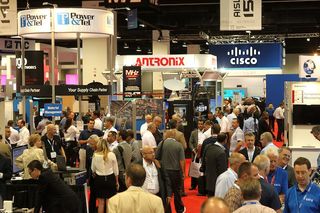SCTE Cable-Tec Expo: Capacity Observations

DENVER — Capacity. It’s always a hot ticket at tech-fests, like the 2014 Society of Cable Telecommunications Engineers Cable-Tec Expo, staged during a week of Colorado gorgeousness. (The last time Expo graced Denver, it was Blizzard City.)
Here’s a weave of notable trends about capacity, gleaned from four jam-packed days of impressively nerdy tech-talk.
The next brink of capacity expansion maneuvers is at hand, and like the last time, engineers characterize their options as “tools in the toolbox.” Usually there are three.
Last time, they were: Switched digital video; building out to 1 Gigahertz, spectrally; and analog spectrum reclamation to make room for all-digital transmission.
Three is the number this time around, too. The front-runner: DOCSIS 3.1, the next grand slam in broadband capacity expansions, which doubles capacity in the forward, or downstream, and reverse, or upstream, signal directions. According to panelists at the DOCSIS 3.1 Symposium preceding Expo, we’ll start seeing those modems and gateways sometime next year.
Second, and harder to swallow because it involves labor costs, is any of the many flavors of “fiber-deeper.” While it’s never fun to be the guy digging through the petunias to attach a new wire to the house, sometimes it just makes sense: New builds. After a catastrophic event.
It is in this category that you hear talk of “remote PHY,” “RFoG” and “distributed CCAP,” among others.
Option three goes higher again, spectrally — to 1.2 GHz and even 1.7 GHz; the DOCSIS 3.1 spec mentions both. These days, some operators have built to 1 GHz; most sit at either 750 Megahertz or 860 MHz.
Going to 1.2 GHz tastes delicious, at first. Depending on the starting point — which involves how amplifiers are spaced on the wires — a move to 1.2 GHz bumps overall downstream capacity by as much as 60%. (What?!)
Let’s do the math. Say the current spectral top is 750 MHz. If the new goal is 1.2 GHz, which is the same as 1,200 MHz, the difference is 450 MHz. There’s the 60%.
Hang on! Turns out a power predicament accompanies a move to 1.2 GHz, meaning a doubling of the power required to push amplifiers that high. This all came to light at the tail end of an Arris-hosted breakfast on the last day of Expo, when a man in the audience, during the closing Q&A, asked about it.
It’s why we should all be glad for another Big Thing that happened during SCTE Expo: An effort, called Energy 2020, to reduce power consumption “per unit” (per every component in a system, from “cloud to ground”) by 20%, by 2020. It’s an enormously ambitious goal, especially in the face of multiple “power hog” examples, like powering 1.2 GHz plant.
That’s the trajectory of capacity, if the trend lines of the Cable-Tec Expo are true. Which they usually are.
Stumped by gibberish? Visit Leslie Ellis at translation-please.com or multichannel.com/blog.
Multichannel Newsletter
The smarter way to stay on top of the multichannel video marketplace. Sign up below.
